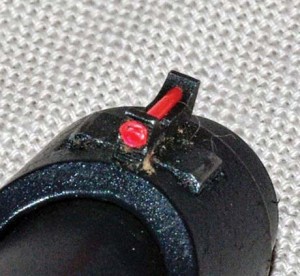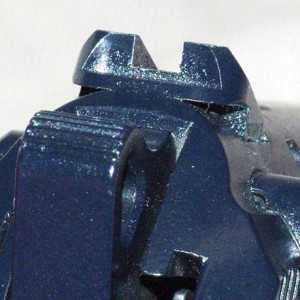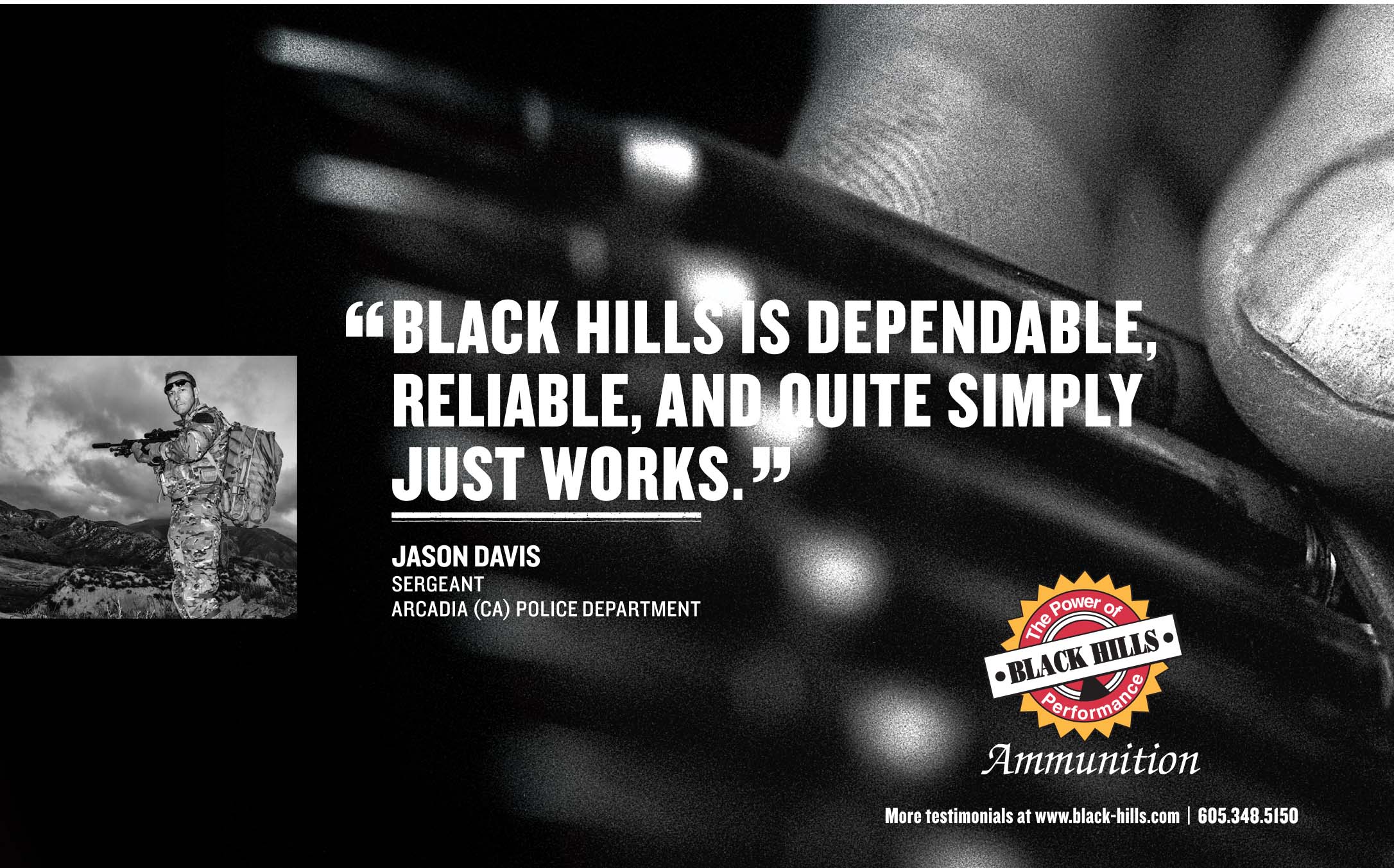by Scott Smith | Contributing Editor
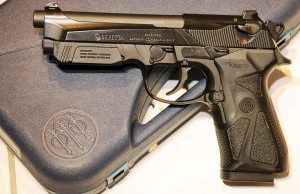
If you are looking for a fine pistol that can be easily customized to fit your needs, the Beretta 90TWO, shown here with the storage case, is a pistol to consider.
Over the past years I have seen many firearms come and go. The reasons vary: from not being marketed well; or there were too many cool must haves out there; or they were too pricey, or they were just overlooked. Today and for the last five or six years the pistol market has been dominated by striker-fired pistols. Traditional single/double-action pistols tend to be considered dinosaurs and are often overlooked when they should not be.
One such pistol is the Beretta 90TWO. The 90TWO like the M9/92FS is a traditional single/double-action with the open slide Beretta made famous. The safety/de-cocking lever combo is slide mounted and more rounded than the original design. Like the M9/92FS, the 90TWO ships with two enhanced 17-round magazines (where legal) replacing the 15-round models that shipped with the M9s.
When you open the box you will notice the wrap-around polymer grip and the accessory rail. The grip is interchangeable; the grip that ships with the 90TWO gives you the feel of an M9, while the replacement gives you the feel of the smaller more 1911-like grip of Beretta’s retired Vertec. You will also notice the trigger guard is rounded instead of boxy.
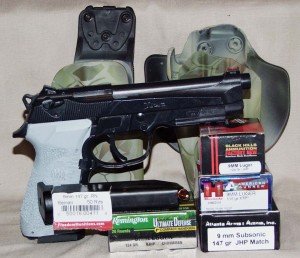
The 90TWO with its Duracoat finish with holsters from BladeTech(L), Safariland(R) and its test ammo. Freedom Munitions fills this magazine after a local USPSA match.
Another feature that sets this pistol apart from other Berettas is the angled slide. This feature gives the pistol a more modern look when put next to a traditional slide, but it makes holster fit an issue. This in my opinion was one of the reasons for this pistol’s low sales numbers. The big move forward with the 90TWO slide was dovetailing the front sight, allowing shooters to easily install fiber optic and tritium sights.
To find one of this pistol’s best features you must take the pistol apart like you would to clean it. First remove the magazine, then lock the slide to the rear ensuring the pistol is clear, then push the slide lock button on the right side of the frame which allows you to rotate the slide lock and remove the slide. Once the slide is removed you will notice what many consider one of the biggest advances in the “90” series. Beretta installs a polymer recoil shock buffer. This buffer keeps the falling block of the barrel locking mechanism from battering the frame and locking block. You also will find this feature on the 92A1/96A1 pistols.
Taking the 90TWO to the range proved that Berettas, no matter the improvements, are still dean nuts reliable and accurate. Initially I fired some old reloads that I had on hand to see if they would cause the 90 to fail; they didn’t. The slide may have moved visibly slower thanks to the light loads but it extracted and loaded a new cartridge every time. Even with nasty looking rounds of questionable origin, the 90TWO just kept on shooting. This kind of reliability is one of the hallmarks of Beretta pistols. This feature is a must for a pistol used for self-defense, duty or competition; this is a huge selling point.
We used Atlanta Arms and Ammunition (Phone: 770-788-5200; Online: atlantaarms.com) 147-grain JHP Match, Black Hills Ammunition (Phone: 605-348-5150; Online:black-hills.com) 124-grain JHP, Freedom Munitions (Phone: 208-746-3668; Online: freedommunitions.com) 147-grain FMJ-remanufactured, Hornady’s (Phone: 800-338-3220; Online: hornady.com)115-grain XTP American Gunner and Remington’s (Phone: 800-243-9700; Online: Remington.com) 124-grain Ultimate Defense BJHP with which the 90TWO consistently shot 3½”, 5-shot groups off the bench at 25 yards. I know that might be a staggeringly boring group to those who shoot bullseye or CMP. You have to remember this is a duty weapon and it shot these groups with all the loads tested.
Customizing Additions
With this consistent performance I knew the pistol had potential for 3-Gun and action pistol competition; it just needed some help. First the chunky factory sights had to be replaced; a $39 fiber optic front from Dawson Precision (Phone: 866-300-1911; Online: dawsonprecision.com) and a $34.95 Novak (Phone: 304-428-2676; Online: novaksights.com) Lo-mount rear were installed. This combination gives a clear sight picture that allows for accurate, quick shot placement.
Next the trigger needed to be easier to manipulate, so I installed a Wilson Combat (Phone: 800-955-4856; Online: wilscomcombat.com) Short Reach Steel Trigger (SRST) at $28.95 and the reduced power Trigger Conversion Unit at $19.95 to reduce the trigger pull. I have installed the SRST on other 92 series pistols that have been shot by many people and they all said the same thing; they didn’t think the trigger would make the huge difference in the fit of the pistol. Several of the folks who have shot my various Berettas carried the M9 in the sandbox and said the SRST makes the pistol user-friendly. Lastly, I textured the grip to give a better grasp in all conditions and, to make magazine changes easier, a $41.95 Wilson Extended Magazine Release replaced the factory release. Unlike many drop-in parts which make pistols look better, these all make the pistol easier to shoot accurately with faster target acquisition.
After installing the parts from Wilson Combat, it was time to return to the range and see if the additions improved the 90TWO’s performance. To make sure the testing was fair we used the same loads we did when the pistol was stock. First sight alignment was verified ensuring they were centered and properly regulated for point of aim/point of impact and found the pistol was still dead on at 25 yards. With better sights we found the 90TWO was consistently shooting sub-3-inch 5-shot groups with our initial test ammunition and most of the popular self-defense/duty ammunition on the market.
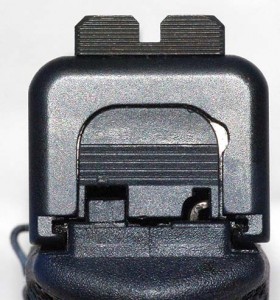
Way of the Gun’s Proctor “Y” Notch gives you the accuracy of a standard box and speed of a “u” notch rear sight.
What we did find during this second set of range sessions was the 90 is a consistent shooter. I have seen many pistols not like 147-grain loads, especially remanufactured ones like those from Freedom Munitions. Not the 90, it fed them flawlessly. When I took the best 3 rounds from each of the 5-shot groups, the 90TWO showed amazing accuracy, with the groups all hovering at 1½”. The other three loads all averaged 2” or just a hair over. With its improvements the 90TWO is ready for any match.
Holsters
I was glad to see that Blade Tech (Phone: 877-331-5793; Online: blade-tech.com) and Safarliand (Phone: 800-347-1200; Online: safariland.com) holster companies have built solid reputations for quality gear that meets or exceeds a customer’s needs.
With the primary use of the 90TWO being competition, I chose holsters that function well for that task. Blade-Tech’s traditional OWB has been one of the dominant holsters in IDPA and USPSA for many years. With its $64.99 price point, multiple mounting options as well as being offered in various colors of Kydex, this holster is tough to beat. Wanting the holster to be versatile, I chose the offset Tek-Lock which holds the holster close to the body and allows for a quick draw.
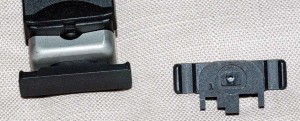
Tac Rack, it makes clearing malfunctions easier and gives you something to rack the slide with when you low mount a mini red dot.
If you prefer a security holster, the new Safariland 578 GLS Pro with its $55 price tag is tough to beat. The 576/577/578 family of holsters was introduced at the 2015 SHOT Show as a one-size-fits-all security holster that truly fits nearly all the common duty, competition, CCW pistols on the market. This is accomplished via a tension screw and a removable wedge in the trigger guard. The security device grips the trigger and is released as you grip the pistol without changing your firing grip. The 578 I use for the 90TWO also fits my 92G, Elite II, and 92A1Berettas.
Over the last few months I have found the enhanced 90TWO with the Blade-Tech/Safariland holsters to be a fine all-round-use pistol. Just because a pistol like the 90TWO was not a huge retail success is not a reason to pass it up. This pistol is built like its military sibling the M9/92FS and shares 99% of its parts, only the grip and captured recoil/guide rod
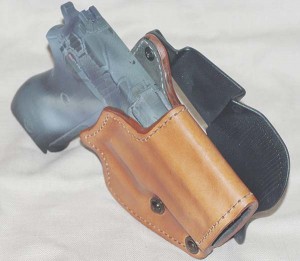
Front Line Holster’s LKC38P-BR paddle holster fits my well traveled Sig Sauer P225 like a glove; you can see the suede, Kydex and leather layers in this image.
are different. I like this pistol well enough that the pistol was finished with Lauer Weaponry’s (Phone: 800-830-6677; Online: lauerweaponry.com) DuraBlue, which gives the pistol that old school high polish blue look. Through hundreds of dry fire and live fire draws, I have not seen any wear marks; this is a tough finish. With its Navy Work Uniform Light Blue grips, the 90TWO looks as good as it performs. Keep an eye out at your local firearms dealer for a Beretta 90TWO; you won’t be disappointed if you purchase one.
I hope we have shown you not to overlook forgotten pistols like Beretta’s 90TWO. There are many fine pistols on the market that time and advertising have forgotten. When you see new things like sights, holsters and other small accessories, do not assume they are all just gizmos.
Additional Suggestions
If you want to improve your Glock or M&P, might I suggest Proctor Y Notch Sights from Way of the Gun (Online: wayofthegun.us) These sights are the brainchild of Frank Proctor, a former Special Forces Operator who was an instructor at the SF Advanced Urban Combat Course and has also achieved Limited Class Grandmaster in one year. These sights are designed by a shooter. Proctor’s Y Notch has a truly unique design. Unlike traditional sights that use a square notch or now “u” notches; Proctor’s use a Y notch rear.
The front sight is 0.117” wide with 0.040” fiber optic pipette. This splits the difference of many sights that are 0.125” or 0.100” which are either too wide for precision shooting but durable as a duty sight or too fragile to survive hard use while pinpoint precise for bullseye shooting. From what I have seen these sights work well for both.
As the name implies the rear sight has a 0.140” Y notch. What this does is allow additional light for fast target acquisition like a “u” notch rear, while giving the precision of a box notch. Like a “u” notch, the eye naturally centers the fiber optic in the notch of the “Y” without having to mentally guess if the sight centered. There is a lot of biomechanics involved in why your eyes do this, but we will keep it simple and just say it’s a human thing.
I found with the Proctor “Y” Notch Sights installed it made my Glock 21SF easier to shoot well. The G21SF has been my test bed pistol for the numerous Glock accessories on the market because it is wicked accurate, it fits my hand well and it is a good pistol to test gear while competing in various action shooting events, because the G21SF is chambered in 45ACP. During various range exercises the Y Notch Sights gave me faster, tighter groups at 15 yards, consistent groups at 50 yards and simply fast groups at close range.
I found at close ranges (seven yards or less), if the red fiber optic was anywhere in the “Y”, the G21SF would make “A” zone hits. The front sight width to rear sight notch width relationship gives what many gun scribes refer to as combat accuracy; being able to shoot a five-shot group that your hand can cover. In competition shooting that is fast “C” zone shooting for USPSA and 3Gun, while they also shine where accuracy rules in games like IDPA.
If you sit and truly test the sights, you will find they give you precision hits with the front sight fiber optic in the notch and true precision POA/POI when the front sight rests where the leg of the Y meets the “v” in the Y. I like this over the age-old six o’clock hold theory because it just seems faster. These sights are a good value at$79, check them out.
Another product that was born from combat is Mako Group’s (Phone: 631-843-0490; Online: idfholsters.com), Front Line Holsters. Front Line manufactures more than three thousand holsters to fit virtually any duty pistol on the market today. What drew me to look at Mako Holsters was the number of holsters they offer for a Sig P225.
I chose to look at the LKC38P-BR, leather suede lined, right side, straight drop paddle, retailing at $73.75. This holster is virtually uncrushable thanks to the layer of Kydex that is laminated and sewn between a leather outer layer and suede lining for silent drawing and holstering. The pistol is retained by the compression fit and dual retention screws. What sets this holster apart from others is that you have three height adjustments to give you custom placement of the pistol.
The paddle channel is designed to fit a one and a half inch belt. The belt secures via a ledge on the paddle and it is stable and secure. The holster stayed centered on my hip getting in and out of the truck, working around the yard on the range, etc. I like paddle holsters when you are changing clothing frequently and for competition. Mako’s LKC38P is one of the best examples of a truly concealable paddle holster I have used. This holster is available for most any common duty pistol.
Speaking of holsters, I have been asked many times how do I get the patterns on my holsters that I compete with. If you can follow the directions of numerous Youtube videos on how to: apply stencils from Montactical (Online: montactical.com); properly mix Duracoat, and use an airbrush, you can have custom finishes on your gear and firearms. I do suggest practicing on something cheap such as cardboard or well-worn polymer gear before applying finishes to your good gear. I found that the stencil material Montactical uses is one of the easiest to apply, especially to create a kryptekish pattern or Montactical’s hexagons.
Once you ensure the material is clean and oil free, apply one or two base colors—the airbrush allows you to feather them, allow the initial coats to dry overnight, then apply the first stencil. At this point you can apply one or two contrasting colors which will highlight the pattern. If you want to have detailed lines at this point, after drying apply the inner stencil and repeat. At this point you have your custom finish. I found the videos on Montactical’s website to be some of the most informative on the net and like me they use Duracoat. This combination allows you to get DIY results, you can also have Montactical do the finish for you. From what I have seen of their gallery images, you would be hard pressed to find a better job; more importantly the staff is top notch to deal with. Montactical can supply you with both the stencils and Duracoat; tell them TheGunMag sent you.
Finally we are going to look at the TacRack (Online: wrightshooting.com). My buddy Brandon Wright of Team Smith&Wesson/Team ITI and Fritz Borke designed this gizmo. At least I thought it was a gizmo when Brandon gave me a sample at the SHOT Show. Having a lot of respect for Brandon, I said I would give this 6061 machined-aluminum slide cover plate a look see and mount one on my race Glock 17 and M&P 9 when I got home.
The Tac Rack simply replaces the factory slide plate cover. Once I had my samples installed, my initial concerns were overcome. The biggest concern was that it would rub your hip when wearing your pistol or it would interfere with acquiring a shooting grip. The TacRack did neither.
What I did find with the TacRack is that it makes racking the slide of my race Glock easier since there is actually a place to grab on. When a mini red dot is low mounted to a Glock, getting a grip to rack the slide is problematic. I found that neither my M&P nor G17 rubbed my hip with the TacRack installed; there was no interference with any of my holsters, even the new 576GLS from Safariland. I had several of the folks at the range see what they thought. Two of the guys had bad grips from injuries and age. They found the TacRack-equipped pistols easy to operate. We also found this “gizmo” makes clearing jams easier reducing the likelihood of tearing off a rear sight. If you are running a mini red dot, the TacRack is a must to keep from using the sight as a charging handle. If you run a Glock 43, Springfield XDS or an M&P Shield, spend the $29.99.
Have a safe fall whether you are finishing the competitive season or preparing for hunting season; be safe, shoot straight and have fun.

